Cutting a Cube/Cuboid
Number of smaller cubes
(Finding the number of smaller cubes when a bigger cube or cuboid is cut)
When we cut a rod once, then it divides into how many parts?
When we cut a rod once, then it gets divided into two equal parts.

Similarly, if we cut a rod twice, then it divides into three equal parts.
 And so on…
And so on…
Can we generalize?
If number of cuts = (n -1), then number of parts in which a rod or a line gets divided into = n
A cube can also be cut as a rod/stick/line.
If a cube of X cm long sides is cut into equal smaller cubes of sides Y cm, then n = X/Y
(n is the number of smaller cubes on each edge.)
If these cuts are made along all the three dimensions, i.e. along the length, breadth and height, then we will get smaller cubes of same size.
Total number of such smaller cubes = $n^3$
Q. If the edge of a cube is 10 cm and it has to be cut into smaller cubes each having edge of 2 cm, then:
- Each edge of the cube has to be cut how many times?
- Whole cube will has to be cut how many times?
- What is the number of smaller cubes thus obtained?
Explanation:
And to divide into five parts, each edge will have to be cut 5-1 = 4 times
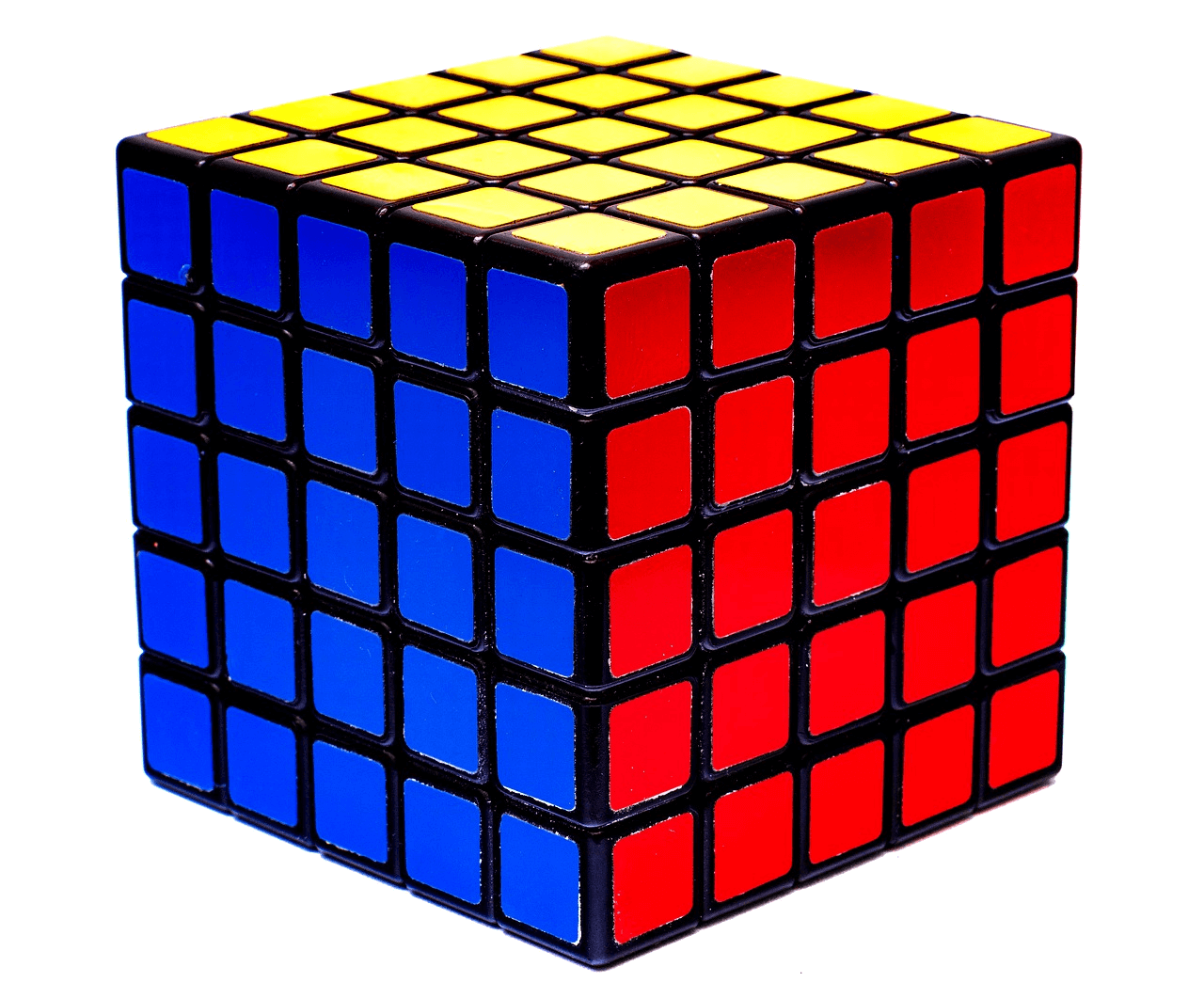 Hence, the number of times the cube has to be cut = 4×3 = 12
Hence, the number of times the cube has to be cut = 4×3 = 12Number of smaller cubes = $n^3$ = $5^3$ = 125 (Basically, it’s length × breadth × height)
What if it’s a cuboid?
Can we still count the number of smaller cubes?
When a cuboid is cut into smaller cubes of equal volume, then:
Total number of Cubes = $ \frac{Vol. \hspace{1ex} of \hspace{1ex} Cuboid}{Vol. \hspace{1ex} of \hspace{1ex} smaller \hspace{1ex} cube} $
= $ \frac{Length × Breadth × Height \hspace{1ex} of \hspace{1ex} cuboid}{(Side \hspace{1ex} of \hspace{1ex} smaller \hspace{1ex} cubes)^3} $
Let’s consider an example.
Q. If a cuboid with length = 10 cm, breadth = 8 cm and height = 6 cm is cut into smaller cubes of edge 2 cm each, then find the number of smaller cubes.
(a) 72 (b) 42 (c) 48 (d) 60
Explanations :
Total number of Cubes = $ \frac{Length × Breadth × Height \hspace{1ex} of \hspace{1ex} cuboid}{(Side \hspace{1ex} of \hspace{1ex} smaller \hspace{1ex} cubes)^3} $ = $ \frac{10 × 8 × 6}{2^3} $ = 60
Total number of Cubes = No. of cubes along length × No. of cubes along breadth × No. of cubes along height = (10/2) × (8/2) × (6/2) = 5 × 4 × 3 = 60
Q. How many cubes are there in this cuboid?

Explanation:
Types of smaller cubes
After cutting a cube, following four types of smaller cubes are obtained:
(we are taking an example of a cube where there are 3 cubes on each of its edges, i.e. n = 3)
Corner cubes
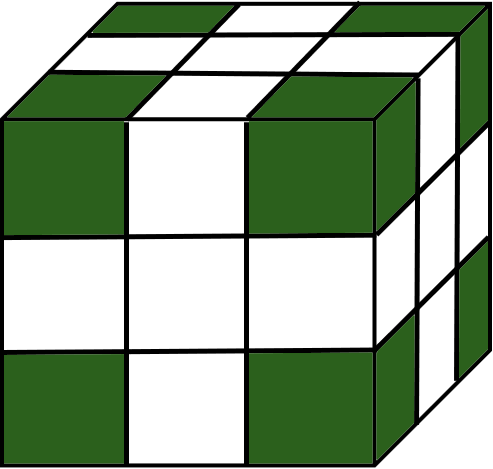 Number of corner cubes = 8 (always)
Number of corner cubes = 8 (always)No smaller cube can have more than three painted faces under normal circumstances.
Cubes at the middle of each edge
Number of middle cubes = 12 (n - 2)
OR
Number of middle cubes = Number of middle cubes on each edge × 12 (as there are 12 edges in a cube)
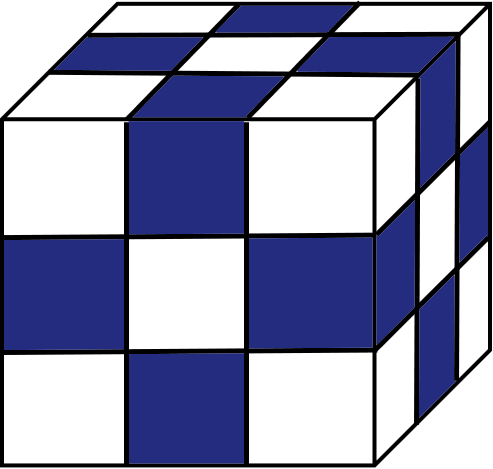 In this case, Number of middle cubes = 12 (n - 2) = 12 (3 - 2) = 12
In this case, Number of middle cubes = 12 (n - 2) = 12 (3 - 2) = 12
Cubes at the centre of each face
Number of such cubes = 6 $(n – 2)^2$
OR
Number of such cubes = Number of middle cubes in each face × 6 (as there are 6 faces in a cube)
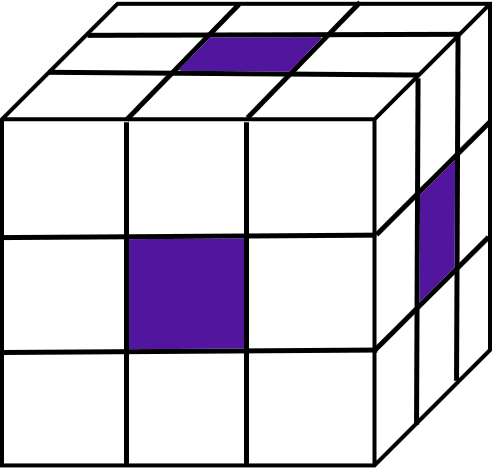 In this case, such cubes = 6 $(3 - 2)^2$ = 6
In this case, such cubes = 6 $(3 - 2)^2$ = 6
Inner cubes that are hidden
Number of inner cubes = $(n - 2)^3$ In this case, such cubes = $(n - 2)^3$ = $(3 - 2)^3$ = 1
or $n^3$ = 8 + 12 (n - 2) + 6 $(n – 2)^2$ + $(n - 2)^3$
In our example:
$3^3$ = 8 + 12 + 6 + 1
or 27 = 27
Hence, we have accounted for all kinds of smaller cubes.
Q. If a larger cube of 8 cm edge is cut into smaller cubes of equal volumes, each having edge of 2 cm, then:
Number of smaller cubes = ?
Number of corner cubes = ?
Number of cubes at the centre of edges = ?
Number of cubes at the centre of faces = ?
Number of inner cubes (N) = ?
Explanation:
Number of smaller cubes = $n^3$ = $4^3$ = 64
Number of corner cubes = 8 (always)
Number of cubes at the centre of edges = 12 (n - 2) = 12 (4 - 2) = 24
Number of cubes at the centre of faces = 6 $(n – 2)^2$ = 6 $(4 – 2)^2$ = 24
Number of inner cubes = $(n - 2)^3$ = $(4 - 2)^3$ = 8
Note: If we check, total number of cubes = 8 + 24 + 24 + 8 = 64
Q. A cube of side 4 cm is painted blue on all of its surfaces and then divided into various smaller cubes of side 1 cm each. Find the number of cubes having none, one, two and three faces painted.
Explanation:
Smaller cubes with three faces painted = Number of corner cubes = 8 (always)
Smaller cubes with two faces painted = Number of cubes at the centre of edges = 12 (n - 2) = 12 (4 - 2) = 24
Smaller cubes with one face painted = Number of cubes at the centre of faces = 6 $(n – 2)^2$ = 6 $(4 – 2)^2$ = 24
Smaller cubes with no face painted = Number of inner cubes = $(n - 2)^3$ = $(4 - 2)^3$ = 8
For those who are more into mugging up the numbers, here’s a list of the number of four types of smallers cubes/blocks (got after cutting bigger cubes of various sizes):
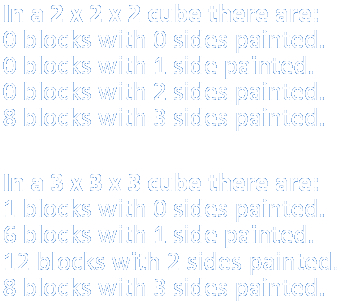
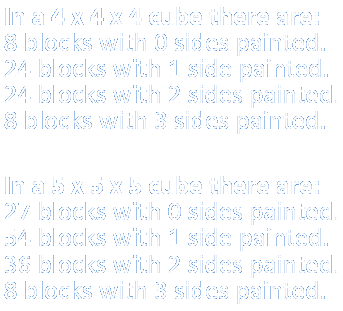
Note: We will solve questions wherein the larger cube is painted with more than one colours and then cut, in a separate module. Here we covered the basics of cutting and painting a cube.